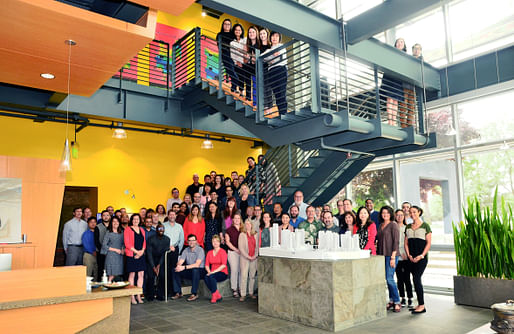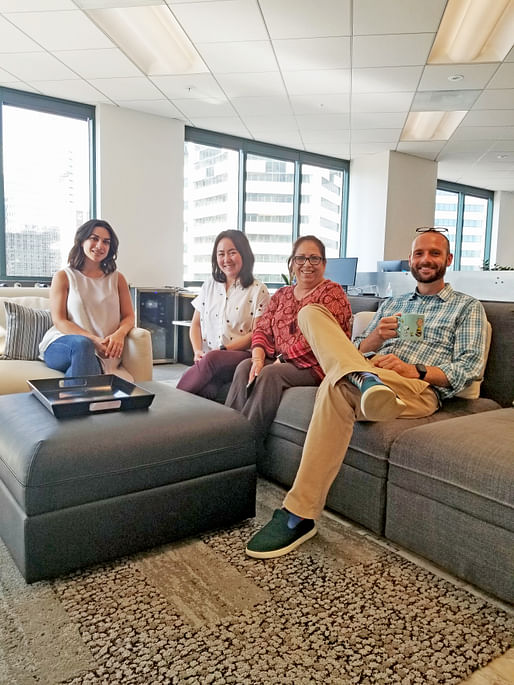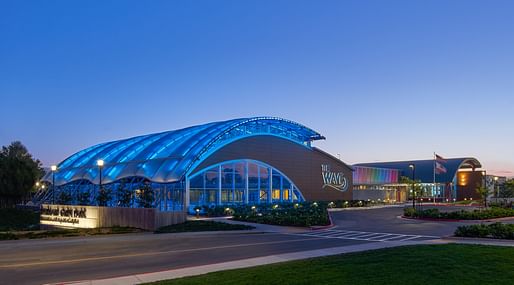
Following last week’s visit to California-based SmithGroup, we are keeping our Meet Your Next Employer series partly on the west coast this week to meet residential specialists DAHLIN.
The 180-strong firm, whose nine offices span California, Washington, Utah, Montana, and Texas, and internationally in China, have emerged from their founding in 1976 to build a residential-led portfolio complimented by commercial, institutional and civic projects.
Over on Archinect Jobs, the firm is hiring for a wide variety of positions and locations, from multifamily project managers in Texas to commercial job captains in California. For candidates interested in applying for a position, or anybody interested in learning more about life at the firm, we spoke with the DAHLIN team for a behind-the-scenes look at their studio.

How did DAHLIN get started?
Doug Dahlin started out on his own in the small coastal California community of Bolinas before relocating to Danville in the East Bay of the San Francisco Bay Area where he officially founded the firm in 1976. Shortly after he hired his first employee, John Thatch – now our Senior Vice President of Design Innovation, and in 1979 the firm started our first significant legacy project spanning nearly a decade, Blackhawk. We were involved in every facet of the community’s design from the planning to the award-winning Blackhawk Tennis & Swim Club – our very first recreational facility. In fact, Doug bought a house in the community, raised his family there, and still lives there today.
This started our legacy of design in placemaking, integrating planning and architecture from the very beginning to thoughtfully design entire places – the buildings and the spaces in between – for people. We have built upon that legacy to grow into a multidisciplinary firm that integrates planning, architecture, and interiors with locations throughout the Western United States. Our portfolio covers residential design at all scales and typologies for market-rate, affordable housing, and senior living; civic; commercial; healthcare; and education.

How big is your team?
We are an ESOP firm of 180 people across nine locations and growing to meet the needs of our clients.
Is your team currently working remotely, in-person, or hybrid?
We work in a hybrid model that empowers our staff with the flexibility they need to be at their best without sacrificing the unique characteristics of in-person collaboration to create an environment in which our people can flourish as whole human beings.

Do your offices interact much or are they independent?
Our offices are highly collaborative, from design to operations. Our philosophy has always been to staff projects based on alignment of skills with the client’s goals and the project’s needs rather than limiting ourselves to whoever happens to be closest to the project. Consequently, we do not run our offices as separate profit and loss centers, and as a result, it is very common for a project team to have staff from multiple offices on the team and to have someone from planning, architecture and/or interiors either on the team or acting in an internal advisory role.
We also have a variety of internal specialized groups that are intentionally inter-office, inter-disciplinary, and inter-market sector, such as our Diversity, Equity and Inclusion group, our Sustainability group, and our Design Technology group.
Are your offices open-plan or subdivided?
Our offices are open-plan with a balanced blend of 'me' and 'we' spaces that provide areas conducive to working independently as well as areas for in-person, virtual, and hybrid collaboration sessions.
What do your offices ‘sound’ like? Do you listen to music or radio at work, can you hear the street life outside, are design conversations had in the open, or is it a place of quiet work?
We like to think we have just the right amount of lively – not overly noisy, but not whispery quiet. Our seating arrangements are open; therefore, most of the design and technical conversations, as well as almost everything in between – including a bit of music – are in the open and everyone is encouraged to participate. People are encouraged to talk with each other, regardless of whether it is about work or not as it is part of our culture and how we get to know one another. We are sensitive to when others are on virtual calls, but interactions still happen, just at a lower level.
If you were to give each member of your firm one reading assignment, what book would you ask them to read?
Start With Why by Simon Sinek. Understanding the why of everything we do is the key to successful decisions and meaningful design solutions.
If your firm was given $1M to donate to one charity, which one would that be?
We would donate to HomeAid, which is the charitable arm of the Building Industry Association dedicated to helping people experiencing or at risk of homelessness build new lives through construction, community engagement, and education. It has been our privilege to partner with HomeAid over the years, contributing our time and expertise to designing housing for people who need it. DAHLIN President Nancy Keenan currently serves as Board Chair for their Northern California chapter, and she is an avid supporter of DAHLIN staff engagement on HomeAid project teams.
What do you believe is the single biggest issue/crisis facing the U.S. built environment today?
Housing affordability and equity, which is compromising the social stability of our country. Unfortunately, the issue of homelessness, especially in urban areas of California is impacting our environment in ways that were not predicted. Because housing and services are out of reach for some people, far too many are living on the streets. The solutions extend beyond what design alone can solve, but as designers we have opportunities to influence ways of providing the needed housing and support services.
What are the most popular design tools or software in your offices?
We are committed to the integration of 3D design and documentation in our design process, and as such the most popular tools in the firm are Sketchup for design and Revit for documentation. These programs help to present and convey the design ideas and programming to the client and better communicate the construction process at the job site. Additionally, our Design Technology group is always exploring the ever-evolving technology landscape and experimenting with how to integrate new tools into our design process.
Is there a particular sector that you operate heavily in, or are you an all-rounder?
Our roots are in homebuilding and urban planning, and as such, residential planning, architecture and interiors represent a significant portion of our work. Within residential design, we are well diversified – having both breadth and depth – from single family detached to multifamily across market-rate, affordable housing, and senior living. Our planning work spans community master plans to specific plans to design guidelines.
We also have a sizeable portfolio of community and recreational facilities for both private and public sector clients that include projects such as community centers and clubhouses, senior centers, events centers, recreational facilities, aquatic complexes, and golf clubhouses. Our youngest market sectors, Commercial, Healthcare and Education, are healthy, growing sectors though naturally smaller relative to our residential sectors.
Tell us about a recent completed project you are proud of.
The Muriel E. Mayes Center for Women and Children for the Bay Area Rescue Mission (BARM) Center for Women and Children in Richmond, California. The project opened earlier this year and is providing much needed housing and services for homeless and abused women and children throughout the San Francisco Bay Area.
On any given night, women and children comprise 60% of individuals experiencing homelessness in the Bay Area, and it is very gratifying to know that good design can support the dignity of otherwise homeless individuals and – to quote Sherwin from BARM, “Women arriving at this beautiful building from the streets will feel safe and motivated to participate in the programs that will support them in building a new life.”

What position(s) are you currently hiring for?
We are looking for creative Designers, Job Captains, Architects, and administrative professionals in our CA, TX, and UT locations. More details can be found on our jobs page.
What project(s) are the new team members likely to be working on?
Our current openings are on various residential and multifamily teams. Thanks to DAHLIN’s diversified and growing portfolio of residential, commercial, institutional and civic work, employees will also have the opportunity for stretch assignments in a variety of projects. Check out some of our projects on our profile.
In three words, how would you describe your team’s design ethos?
Innovative, Real, Achievable

Meet Your Next Employer is one of a number of ongoing weekly series showcasing the opportunities available on our industry-leading job board. Our Job Highlights series looks at intriguing and topical employment opportunities currently available on Archinect Jobs, while our weekly roundups curate job opportunities by location, career level, and job description.
3 Comments
Handrails in the first photo look too high for the child standing in front of the stair.
You're kidding, right?
the kid can phase through glass.
Block this user
Are you sure you want to block this user and hide all related comments throughout the site?
Archinect
This is your first comment on Archinect. Your comment will be visible once approved.